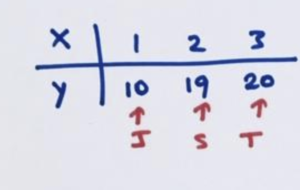Quadratics
6.1 Putting the BIG RESULT to Use!
Lesson materials located below the video overview.
SETTING THE SCENE
We ended the last essay on a big note:
The graph of any quadratic equation \(y=ax^2+bx+c\) is sure to be a symmetric U-shaped curve, situated somewhere in the plane.
And the important word here is symmetry. As we full well know, once we have symmetry in a scenario, we have a good friend at our aid!
In this lecture, we’ll show how the simple power of symmetry makes the graphing of quadratic equations beautifully natural and stunningly straightforward!
But first, here is something curious.
My full names is James Stuart Tanton and my initials thus are JST. So consider this quadratic equation:
\(y=-4x^2+21x+7\).
Put in the values 1, 2, and 3 in turn and out come the values:
\(-4\cdot 1^2+21 \cdot 1-7=10\)
\(-4\cdot 2^2+21 \cdot 4-7=19\)
\(-4\cdot 3^2+21 \cdot 3-7=20\).
And notice: The 10th letter of the alphabet is J, the 19th letter of the alphabet is S; the 20th letter of the alphabet is T. This quadratic spells out my initials!

Many people like to call me JIM. So consider …
READ MORE HERE: QUADRATICS PD Essay 6.1
(See too Edfinity.com/XXX for a robust source of curriculum practice problems for you collate, organise, and use.)
Resources
Books
Take your understanding to the next level with easy to understand books by James Tanton.
BROWSE BOOKS![]()
Guides & Solutions
Dive deeper into key topics through detailed, easy to follow guides and solution sets.
BROWSE GUIDES![]()
Donations
Consider supporting G'Day Math! with a donation, of any amount.
Your support is so much appreciated and enables the continued creation of great course content. Thanks!
Ready to Help?
Donations can be made via PayPal and major credit cards. A PayPal account is not required. Many thanks!
DONATE![]()


